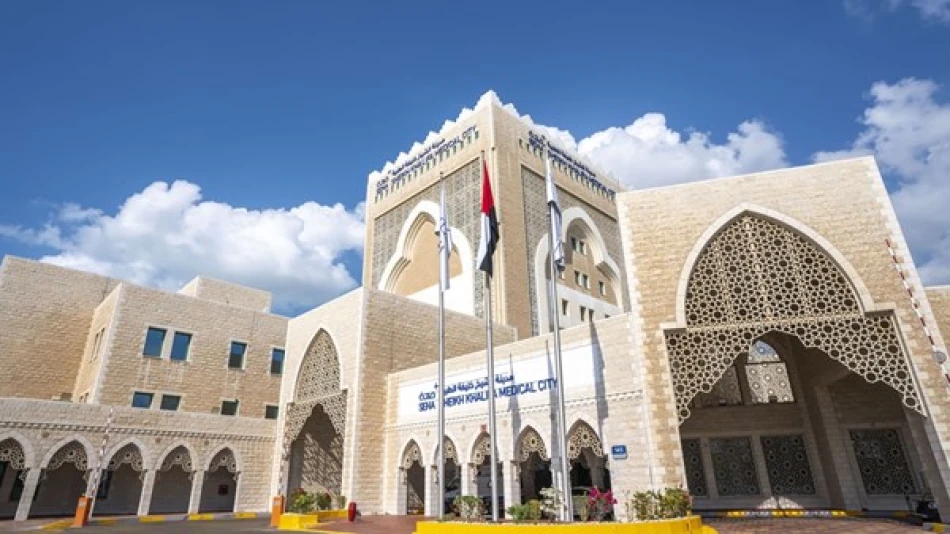
Cutting-Edge Medical Collaboration Saves Rare Childhood Condition
UAE Medical Breakthrough: Complex Multi-System Disease Recovery Signals Regional Healthcare Leadership
A young Emirati girl's recovery from a life-threatening combination of rare diseases at Sheikh Khalifa Medical City demonstrates how the UAE is positioning itself as a global healthcare hub through strategic international partnerships and advanced medical capabilities. The case, involving fulminant hepatitis, influenza A, encephalitis, and secondary hemophagocytic lymphohistiocytosis (HLH), required cutting-edge treatment protocols typically available only in top-tier medical centers worldwide.
The Medical Challenge: A Perfect Storm of Rare Conditions
Meyar Al Balushi's case presented what medical professionals describe as a "perfect storm" of interconnected conditions. The child initially developed fulminant hepatitis alongside influenza A and encephalitis—a dangerous combination that rapidly progressed to secondary hemophagocytic lymphohistiocytosis (HLH), a potentially fatal immune system overreaction.
HLH occurs in fewer than 1 in 50,000 children annually, making it one of pediatric medicine's most challenging emergencies. The condition triggers an uncontrolled immune response that can cause multi-organ failure within days, requiring immediate intervention with highly specialized treatment protocols.
Advanced Treatment Protocol
The medical team at Sheikh Khalifa Medical City, operated by SEHA (part of PureHealth Group), deployed a comprehensive multi-drug approach including:
Immunosuppressive therapy: High-dose steroids and intravenous immunoglobulin to control the overactive immune response
Targeted treatments: Anakinra (an interleukin-1 receptor antagonist) and intrathecal methotrexate to address inflammation in the central nervous system
Supportive care: Plasma exchange, broad-spectrum antibiotics, and multi-organ support systems
Strategic Healthcare Investment Paying Dividends
This successful outcome reflects the UAE's broader strategy to become a medical tourism destination and regional healthcare leader. The partnership between SEHA and Cincinnati Children's Hospital—consistently ranked among America's top pediatric facilities—exemplifies how Gulf states are leveraging international expertise to build world-class medical capabilities.
Competitive Positioning in Medical Tourism
The UAE's healthcare sector has attracted over $2 billion in investment since 2020, with Abu Dhabi and Dubai competing directly with established medical hubs like Singapore and Thailand. Unlike those markets, which primarily serve medical tourists, the UAE is building comprehensive healthcare ecosystems that combine treatment, research, and medical education.
This approach mirrors successful models in countries like South Korea and Israel, where government-backed healthcare investments created both domestic excellence and international medical tourism revenue streams.
The PureHealth Factor: Consolidation and Scale
PureHealth Group's emergence as the Middle East's largest healthcare conglomerate represents a significant shift toward healthcare consolidation in the region. The group's integrated model—combining hospitals, diagnostics, pharmaceuticals, and health technology—creates economies of scale that enable investment in rare disease capabilities and advanced treatments.
This consolidation trend, similar to healthcare system integration in the United States and Europe, allows for more sophisticated care coordination and investment in specialized medical equipment and expertise that individual hospitals couldn't justify economically.
International Partnership Strategy
The collaboration with Cincinnati Children's Hospital goes beyond typical consulting arrangements. It includes knowledge transfer, joint research initiatives, and shared treatment protocols—creating a sustainable model for healthcare excellence rather than dependence on foreign expertise.
This partnership structure has proven successful in other emerging healthcare markets, particularly in Asia, where countries like Singapore built world-class medical sectors through similar international collaborations.
Implications for Regional Healthcare Development
Cases like Meyar Al Balushi's recovery demonstrate tangible outcomes from the UAE's healthcare investment strategy. Successfully treating complex, rare conditions locally reduces the need for expensive medical evacuation to Europe or North America—a common practice for wealthy Gulf families facing serious medical emergencies.
The multidisciplinary approach involving specialists in pediatric intensive care, gastroenterology, hematology, neurology, rheumatology, infectious diseases, nephrology, immunology, metabolic genetics, and general pediatrics showcases the depth of expertise now available within the UAE healthcare system.
For healthcare investors and policymakers, this case validates the economic logic of investing in rare disease capabilities and specialized pediatric care—areas that generate significant medical tourism revenue while serving domestic populations. The success also positions the UAE as a credible alternative to traditional medical destinations, particularly for patients from Africa, South Asia, and other Middle Eastern countries.
 Layla Al Mansoori
Layla Al Mansoori







